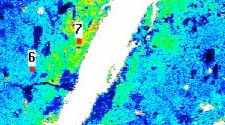
As part of the EC NF-PRO project, Quintessa is developing new models for the alteration of bentonite buffers in contact with corroding iron-based radioactive waste canisters, to understand their possible long-term transformation to non-swelling iron silicates.
Interaction of bentonite with iron is a complex, nonlinear process. Iron corrosion releases Fe2+ ions into the bentonite which could flood sorption sites on the surface and destabilise the clay. In the long term, the bentonite could be transformed to non-swelling silicates (e.g. berthierine, chlorite) which reduces its effectiveness as a buffer. Understanding the fate of the Fe2+ ions is important, as this can contribute to the rate of corrosion. In this study, models of both short-term and long-term iron-bentonite systems have been constructed. For the long-term model, the QPAC code has been used to model the Ostwald Step Process with the aim of capturing the sequential formation of Fe-bearing minerals observed in natural systems.
Image courtesy of Christina Lilja, SKB, and Nick Smart, AMEC.